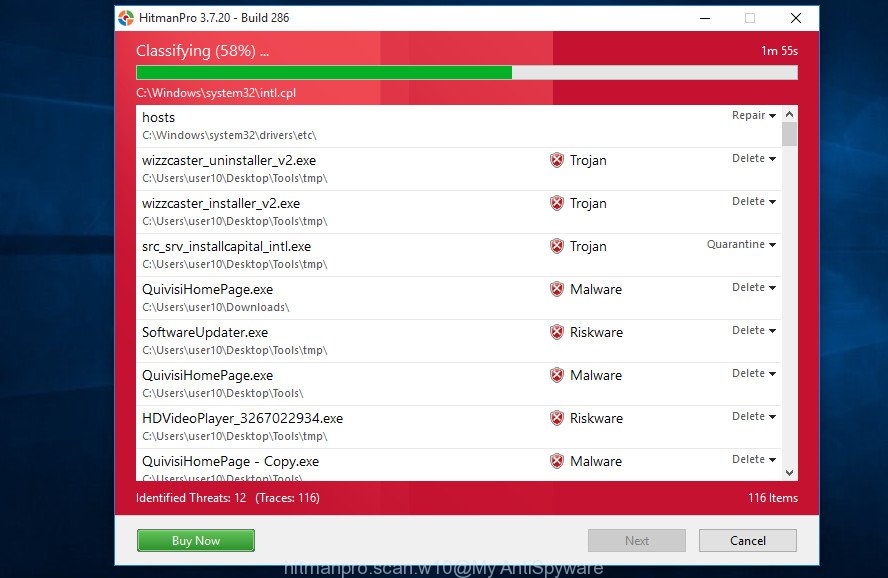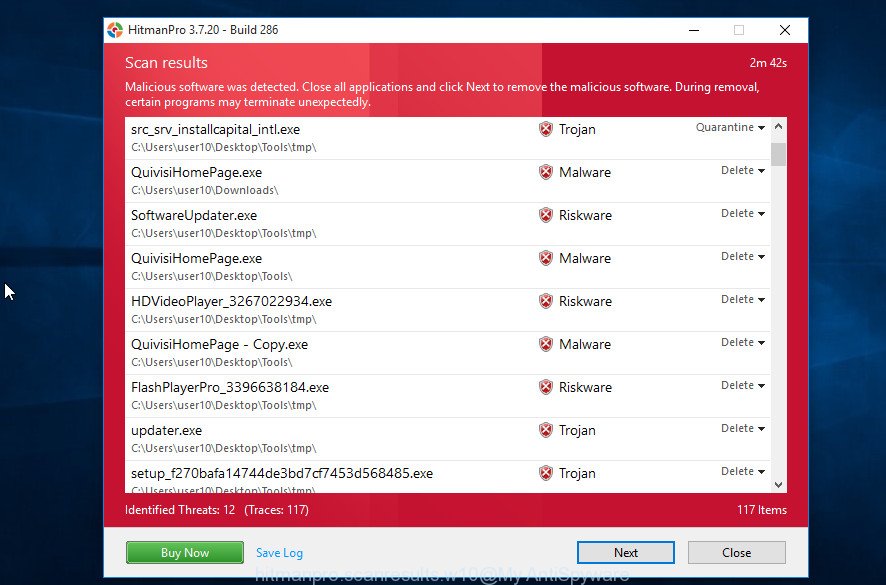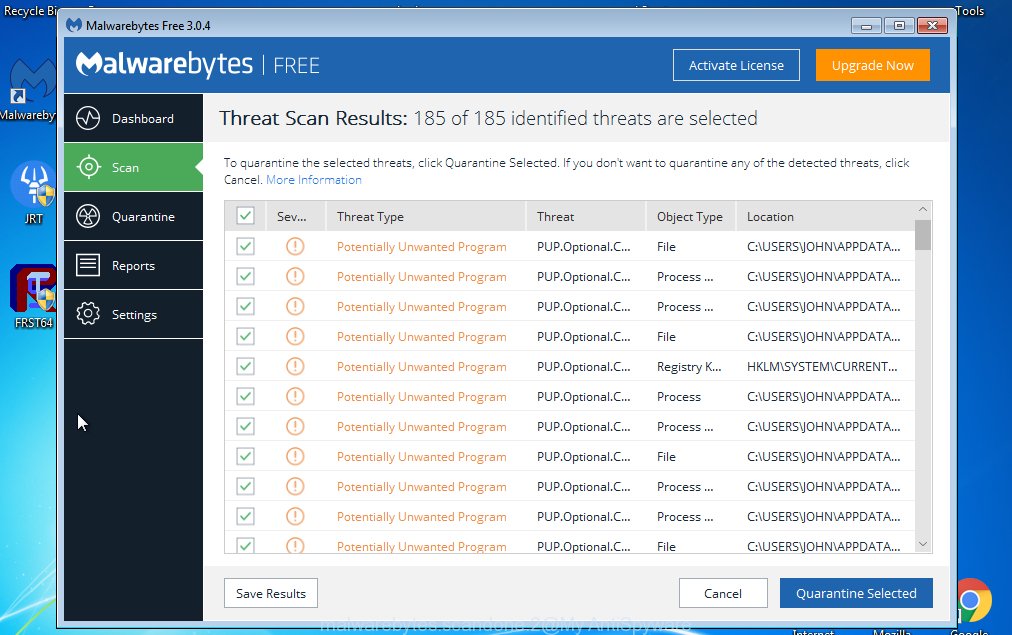What is PUA:Win32/MyWebSearch? If your antivirus software detects PUA:Win32/MyWebSearch then it indicates that your computer is affected by a malicious software. This virus usually come with some free software or from malicious web sites that ask users to download and run a Flash Player or Java update.
Once started, this virus will be configured to launch automatically when Windows starts. It may show a large amount of unwanted pop up ads, inject malicious code into web pages that you are opening in your web browser, hijack web-browser’s settings like startpage and search provider, and so on.
The PUA:Win32/MyWebSearch can steal your private information such as: your ip address, what is a web page you are viewing now, what you are looking for on the Internet, which links you are clicking, and much, much more. This virus may monetize its functionality by collecting data from your browsing sessions and selling it to third party companies. This puts your personal information at a security risk.
We suggest you to clean your PC of this virus without a wait. Use the steps below that will help to remove PUA:Win32/MyWebSearch and ‘ad-supported’ software, which can be installed onto your computer along with it.
How to remove PUA:Win32/MyWebSearch from system
There are a simple guide below which will assist you to remove PUA:Win32/MyWebSearch virus from your Windows PC system. The most effective way to remove this virus is to follow the manual steps and then run Zemana Anti-Malware, MalwareBytes Free or Hitman Pro automatic tools (all are free). The manual steps will assist to weaken this virus and these malicious software removal utilities will completely get rid of PUA:Win32/MyWebSearch virus and restore the computer settings to default.
To remove PUA:Win32/MyWebSearch, execute the steps below:
- Removing the PUA:Win32/MyWebSearch, check the list of installed software first
- Run Zemana Anti Malware to delete PUA:Win32/MyWebSearch
- Scan your system and remove PUA:Win32/MyWebSearch with HitmanPro
- Scan and free your machine of PUA:Win32/MyWebSearch with Malwarebytes
- Delete PUA:Win32/MyWebSearch from Internet Explorer
- Delete PUA:Win32/MyWebSearch from Mozilla Firefox
- Remove PUA:Win32/MyWebSearch virus from Chrome
- Use AdBlocker to stay safe online
- Finish words
Removing the PUA:Win32/MyWebSearch, check the list of installed software first
First method for manual virus removal is to go into the MS Windows “Control Panel”, then “Uninstall a program” console. Take a look at the list of software on your system and see if there are any dubious and unknown applications. If you see any, you need to uninstall them. Of course, before doing so, you can do an Internet search to find details on the program. If it is a potentially unwanted program, ad supported software or malicious software, you will likely find information that says so.
Press Windows button ![]() , then click Search
, then click Search ![]() . Type “Control panel”and press Enter. If you using Windows XP or Windows 7, then press “Start” and select “Control Panel”. It will display the Windows Control Panel like below.
. Type “Control panel”and press Enter. If you using Windows XP or Windows 7, then press “Start” and select “Control Panel”. It will display the Windows Control Panel like below.

Further, press “Uninstall a program” ![]()
It will show a list of all software installed on your PC. Scroll through the all list, and remove any suspicious and unknown apps.
Run Zemana Anti Malware to delete PUA:Win32/MyWebSearch
We advise using the Zemana AntiMalware (ZAM) that are completely clean your system of the PUA:Win32/MyWebSearch. The utility is an advanced malicious software removal program designed by (c) Zemana lab. It is able to help you remove potentially unwanted programs, ‘ad supported’ software, malware, toolbars, ransomware and other security threats from your PC for free.
Zemana Anti Malware can be downloaded from the following link. Save it on your Desktop.
164813 downloads
Author: Zemana Ltd
Category: Security tools
Update: July 16, 2019
When the downloading process is finished, close all programs and windows on your computer. Double-click the install file called Zemana.AntiMalware.Setup. If the “User Account Control” prompt pops up as displayed in the following example, click the “Yes” button.

It will open the “Setup wizard” which will help you install Zemana on your system. Follow the prompts and don’t make any changes to default settings.

Once installation is finished successfully, Zemana Free will automatically start and you can see its main screen as displayed on the screen below.

Now click the “Scan” button to search for PUA:Win32/MyWebSearch virus and other kinds of potential threats like malware and PUPs. This process can take some time, so please be patient. During the scan Zemana Free will find out threats exist on your computer.

When Zemana AntiMalware (ZAM) has finished scanning your system, a list of all items found is prepared. Review the results once the tool has finished the system scan. If you think an entry should not be quarantined, then uncheck it. Otherwise, simply press “Next” button. The Zemana AntiMalware (ZAM) will start to remove PUA:Win32/MyWebSearch related files, folders and registry keys. After the procedure is done, you may be prompted to restart the computer.
Scan your system and remove PUA:Win32/MyWebSearch with HitmanPro
All-in-all, HitmanPro is a fantastic tool to free your system from the PUA:Win32/MyWebSearch virus and other kinds of potential threats like malware and PUPs. The HitmanPro is portable application that meaning, you do not need to install it to use it. HitmanPro is compatible with all versions of Microsoft Windows OS from Windows XP to Windows 10. Both 64-bit and 32-bit systems are supported.
Installing the HitmanPro is simple. First you will need to download HitmanPro by clicking on the following link.
Download and use Hitman Pro on your PC system. Once started, click “Next” button . HitmanPro application will scan through the whole PC for the PUA:Win32/MyWebSearch virus and other security threats. This procedure can take some time, so please be patient. When a threat is found, the count of the security threats will change accordingly.

As the scanning ends, the results are displayed in the scan report.

Make sure all items have ‘checkmark’ and click Next button.
It will show a prompt, click the “Activate free license” button to start the free 30 days trial to remove all malware found.
Scan and free your machine of PUA:Win32/MyWebSearch with Malwarebytes
Get rid of PUA:Win32/MyWebSearch virus manually is difficult and often the virus is not completely removed. Therefore, we recommend you to run the Malwarebytes Free which are completely clean your computer. Moreover, the free application will allow you to remove malicious software, potentially unwanted software, toolbars and adware that your PC may be infected too.

Visit the page linked below to download the latest version of MalwareBytes Free for Windows. Save it on your Desktop.
327070 downloads
Author: Malwarebytes
Category: Security tools
Update: April 15, 2020
Once the downloading process is finished, run it and follow the prompts. Once installed, the MalwareBytes AntiMalware will try to update itself and when this task is finished, click the “Scan Now” button to perform a system scan for the PUA:Win32/MyWebSearch virus related files, folders and registry keys. This process can take quite a while, so please be patient. While the MalwareBytes Anti-Malware (MBAM) program is scanning, you can see number of objects it has identified as threat. Once you have selected what you wish to remove from your personal computer click “Quarantine Selected” button.
The MalwareBytes Free is a free program that you can use to remove all detected folders, files, services, registry entries and so on. To learn more about this malicious software removal tool, we advise you to read and follow the steps or the video guide below.
Delete PUA:Win32/MyWebSearch from Internet Explorer
By resetting IE web browser you return your web-browser settings to its default state. This is good initial when troubleshooting problems that might have been caused by the PUA:Win32/MyWebSearch virus.
First, run the Internet Explorer. Next, press the button in the form of gear (![]() ). It will show the Tools drop-down menu, click the “Internet Options” as shown on the screen below.
). It will show the Tools drop-down menu, click the “Internet Options” as shown on the screen below.

In the “Internet Options” window click on the Advanced tab, then click the Reset button. The Internet Explorer will display the “Reset Internet Explorer settings” window as on the image below. Select the “Delete personal settings” check box, then click “Reset” button.

You will now need to reboot your computer for the changes to take effect.
Delete PUA:Win32/MyWebSearch from Mozilla Firefox
If the Mozilla Firefox settings have been modified by the PUA:Win32/MyWebSearch , then resetting it to the default state can help. When using the reset feature, your personal information such as passwords, bookmarks, browsing history and web form auto-fill data will be saved.
Click the Menu button (looks like three horizontal lines), and click the blue Help icon located at the bottom of the drop down menu as shown in the following example.

A small menu will appear, click the “Troubleshooting Information”. On this page, click “Refresh Firefox” button as shown in the following example.

Follow the onscreen procedure to revert back your Firefox web browser settings to their default values.
Remove PUA:Win32/MyWebSearch virus from Chrome
Reset Chrome settings can help you solve some problems caused by malicious software and remove unwanted changes caused by PUA:Win32/MyWebSearch virus. This will also disable malicious extensions as well as clear cookies and site data. It will save your personal information like saved passwords, bookmarks, auto-fill data and open tabs.
Open the Google Chrome menu by clicking on the button in the form of three horizontal dotes (![]() ). It will show the drop-down menu. Choose More Tools, then click Extensions.
). It will show the drop-down menu. Choose More Tools, then click Extensions.
Carefully browse through the list of installed extensions. If the list has the extension labeled with “Installed by enterprise policy” or “Installed by your administrator”, then complete the following instructions: Remove Google Chrome extensions installed by enterprise policy otherwise, just go to the step below.
Open the Google Chrome main menu again, press to “Settings” option.

Scroll down to the bottom of the page and click on the “Advanced” link. Now scroll down until the Reset settings section is visible, as displayed below and press the “Reset settings to their original defaults” button.

Confirm your action, press the “Reset” button.
Use AdBlocker to stay safe online
We suggest to install an ad-blocker program that can block malicious web sites, undesired advertisements and other annoying web-pages. Computer security professionals says that using ad-blocking software is necessary to stay safe when surfing the Net.
- Download AdGuard by clicking on the link below. Save it to your Desktop so that you can access the file easily.
Adguard download
26842 downloads
Version: 6.4
Author: © Adguard
Category: Security tools
Update: November 15, 2018
- After downloading it, run the downloaded file. You will see the “Setup Wizard” program window. Follow the prompts.
- After the install is done, click “Skip” to close the setup application and use the default settings, or click “Get Started” to see an quick tutorial which will help you get to know AdGuard better.
- In most cases, the default settings are enough and you don’t need to change anything. Each time, when you start your computer, AdGuard will run automatically and stop unwanted pop-up ads, as well as other malicious or misleading web-sites. For an overview of all the features of the program, or to change its settings you can simply double-click on the icon named AdGuard, that is located on your desktop.
Finish words
Now your system should be clean of the PUA:Win32/MyWebSearch virus. We suggest that you keep Zemana AntiMalware (ZAM) (to periodically scan your machine for new malware and other security threats) and AdGuard (to help you stop unwanted pop-ups and harmful web pages). Moreover, to prevent any malicious software, please stay clear of unknown and third party software, make sure that your antivirus application, turn on the option to find out PUPs.
If you need more help with PUA:Win32/MyWebSearch related issues, go to here.


















